Did you know that bees play a crucial part in the growth of our planet’s plants? Not only do they provide us with honey and other products, but their pollination skills are key for creating sustainable ecosystems. But what is it like to be a bee over its lifetime? What roles does a bee have at each stage of its life and how can we protect these hardworking creatures from harm?
In this blog post, we’ll take an in-depth look into the fascinating life cycle of bees, exploring everything from their emergence as larvae to the important duties adults carry out every day!
What are the 4 stages of bee development?
Honeybees have an amazing reproductive process that involves four distinct stages: egg, larvae, pupa, and adult. The bee egg is about the size of an average pinhead and is laid by the queen bee in a cell the honeycomb. When the egg hatches after three days, it enters the larva stage. During this stage, the bee develops legs, antennae, wings, and structures that enable flight. By day six of their development bees enter the pupa stage where they fully transform into adult bees with two eyes, six legs, and two sets of wings. Finally, after 12 to 15 days since emergence from the cell; they become fully developed adult bees with normal social behavior patterns.
What role do bees play in the life cycle of flowering plants?
Bees play a critical role in the life cycle of flowering plants. They are responsible for pollination, which is essential for reproduction. Without bees to carry pollen from flower to flower, many species would not survive. Some studies estimate that one-third of all the food we eat is dependent on pollination from bees and other animals such as butterflies and birds.
Furthermore, by doing their job as pollinators, bees help ensure that plants can continue to grow healthy and strong. All of this illustrates just how important these small buzzing friends are to the natural world around us.
What are all the bee roles?
The bee roles of a colony are diverse among its many different members. Worker bees and drones make up the majority of the hive, with the workers performing all the labor to keep the hive running, collecting nectar and pollen, building hexagonal cells out of wax, feeding eggs and larvae, fanning wings to circulate air throughout the colony, and guarding against intruders.
Female worker bees are also responsible for producing the queen’s food supply of a sweet liquid called “royal jelly.” Despite their peaceful role in the hive, there is an undeniable hierarchical system at work with drones having limited duties that mostly involve mating with other queens from distant hives. Meanwhile, despite taking no part in any manual labor or defense tasks of a colony, every healthy functioning hive relies on its leader; The Queen Bee.
This remarkable creature can lay anywhere between 500-2,000 eggs per day so long as she is well supplied with nourishment and maintained by her beloved group. It is clear why every thriving hive owes so much to every single one of its working parts -no matter how small they may be.
Why are bees important?
Bees are one of the most important creatures on our planet, as they play a vital role in the health of ecosystems and food supplies. Without bees, we would have a harder time growing foods like fruits, vegetables, and nuts due to their pollinating capabilities.
Their activity is estimated to contribute up to $29 billion of global crop value every year – playing a part in one-third of all the food consumed globally! On top of that, bee activity also helps to improve soil quality by controlling erosion and improving soil fertility. This makes them key players in environmental stability and conservation efforts by contributing towards issues such as climate change and nurturing biodiversity. So bees are truly remarkable creatures who can help us build a better future for ourselves and generations to come.
What is the bee process called?
Bees have a complex and fascinating process that plays an essential role in our ecosystems. This natural phenomenon is scientifically known as pollination, which is the transfer of pollen between different flowers and plants.
Pollination provides bees with both food sources and materials for building nests, making it a prime example of how nature can be mutually beneficial to all species involved. Without the process of pollination, most flowering plants would struggle to reproduce, and, subsequently, food production for animals all down the food chain would be at risk. Therefore, pollination is an invaluable method executed by bees to keep our planet balanced and healthy.
Final Reflections: Understanding the Life Cycle of Bees
The life cycle of bees is one of the most fascinating and complex phenomena found in nature. Bees are amazing creatures, able to play a crucial role in human society by pollinating our food sources and producing delicious honey.
We can all appreciate their hard work and commitment to helping the environment. While there isn’t much we can do to understand the life cycle of bees on an individual level, we can learn to appreciate how crucial they are in sustaining both nature and humanity. Knowing more about their life cycle will also help us make better decisions when it comes to interacting with them as well as how to support them in ways such as providing better habitats or floral resources.
Furthermore, studying this topic can provide insights into the biodiversity of insects which could bring forth new technologies or agriculture methods that benefit us further down the line. To create a more sustainable world we must ensure that bees will be able to continue living their life cycles for many generations to come!








